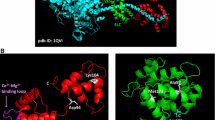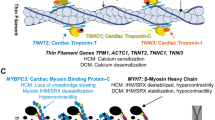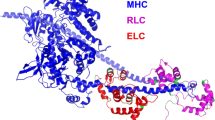Abstract
Through its ability to interact with both the thick and thin filament proteins within the sarcomere, cardiac myosin binding protein-C (cMyBP-C) regulates the contractile properties of the myocardium. The central regulatory role of cMyBP-C in heart function is emphasized by the fact that a large proportion of inherited hypertrophic cardiomyopathy cases in humans are caused by mutations in cMyBP-C. The primary dysfunction in cMyBP-C-related cardiomyopathies is likely to be abnormal myofilament contractile function; however, currently, there are no effective therapies for ameliorating these contractile defects. Thus, there is a compelling need to design novel therapies to restore normal contractile function in cMyBP-C-related cardiomyopathies. To this end, concepts gleaned from various structural, functional, and biochemical studies can now be utilized to engineer cMyBP-C proteins that, when incorporated into the sarcomere, can significantly improve contractile function. In this review, we discuss the rationale for cMyBP-C-based gene therapies that can be utilized to treat contractile dysfunction in inherited and acquired cardiomyopathies.


Similar content being viewed by others
References
Carrier L, Schlossarek S, Willis MS, Eschenhagen T (2010) The ubiquitin-proteasome system and nonsense-mediated mRNA decay in hypertrophic cardiomyopathy. Cardiovasc Res 85:330–338
Chatterjee K, Massie B (2007) Systolic and diastolic heart failure: differences and similarities. J Card Fail 13:569–576
Chen PP, Patel JR, Powers PA, Fitzsimons DP, Moss RL (2012) Dissociation of structural and functional phenotypes in cardiac myosin-binding protein C conditional knockout mice. Circulation 126:1194–1205
Cheng Y, Wan X, McElfresh TA, Chen X, Gresham KS, Rosenbaum DS, Chandler MP, Stelzer JE (2013) Impaired contractile function due to decreased cardiac myosin binding protein C content in the sarcomere. Am J Physiol Heart Circ Physiol 305:H52–H65
Copeland O, Sadayappan S, Messer AE, Steinen GJ, van der Velden J, Marston SB (2010) Analysis of cardiac myosin binding protein-C phosphorylation in human heart muscle. J Mol Cell Cardiol 49:1003–1011
Coulton AT, Stelzer JE (2012) Cardiac myosin binding protein C and its phosphorylation regulate multiple steps in the cross-bridge cycle of muscle contraction. Biochemistry 51:3292–3301
Davis J, Westfall MV, Townsend D, Blankinship M, Herron TJ, Guerrero-Serna G, Wang W, Devaney E, Metzger JM (2008) Designing heart performance by gene transfer. Physiol Rev 88:1567–1651
Day SM, Westfall MV, Fomicheva EV, Hoyer K, Yasuda S, La Cross NC, D’Alecy LG, Ingwall JS, Metzger JM (2006) Histidine button engineered into cardiac troponin I protects the ischemic and failing heart. Nat Med 12:181–189
De Lange WJ, Grimes AC, Hegge LF, Spring AM, Brost TM, Ralphe JC (2013) E258K HCM-causing mutation in cardiac MyBP-C reduces contractile force and accelerates twitch kinetics by disrupting the cMyBP-C and myosin S2 interaction. J Gen Physiol 142:241–255
Desjardins CL, Chen Y, Coulton AT, Hoit BD, Yu X, Stelzer JE (2012) Cardiac myosin binding protein C insufficiency leads to early onset of mechanical dysfunction. Circ Cardiovasc Imaging 5:127–136
Gupta MK, Gulick J, James J, Osinska H, Lorenz JN, Robbins J (2013) Functional dissection of myosin binding protein C phosphorylation. J Mol Cell Cardiol 64:39–50
Hajjar RJ (2013) Potential of gene therapy as a treatment for heart failure. J Clin Invest 123:53–61
Harris SP, Bartley CR, Hacker TA, McDonald KS, Douglas PS, Greaser ML, Powers PA, Moss RL (2002) Hypertrophic cardiomyopathy in cardiac myosin binding protein-C knockout mice. Circ Res 90:594–601
Harris SP, Lyons RG, Bezold KL (2011) In the thick of it: HCM-causing mutations in myosin binding proteins of the thick filament. Circ Res 108:751–764
Hasenfuss G, Teerlink JR (2011) Cardiac inotropes: current agents and future directions. Eur Heart J 32:1838–1845
Herron TJ, Devaney E, Mundada L, Arden E, Day S, Guerrero-Serna G, Turner I, Westfall M, Metzger JM (2010) Ca2+-independent positive molecular inotropy for failing rabbit and human cardiac muscle by alpha-myosin motor gene transfer. FASEB J 24:415–424
Kuster DW, Bawazeer AC, Zaremba R, Goebel M, Boontje NM, van der Velden J (2012) Cardiac myosin binding protein C phosphorylation in cardiac disease. J Muscle Res Cell Motil 33:43–52
Malik FI, Hartman JJ, Elias KA et al (2011) Cardiac myosin activation: a potential therapeutic approach for systolic heart failure. Science 331:1439–1443
Maron BJ, Gardin JM, Flack JM, Gidding SS, Kurosaki TT, Bild DE (1995) Prevalence of hypertrophic cardiomyopathy in a general population of young adults. Echocardiographic analysis of 4111 subjects in the CARDIA Study. Coronary Artery Risk Development in (Young) Adults. Circulation 92:785–789
Marston S, Copeland O, Jacques A, Livesey K, Tsang V, McKenna WJ, Jalilzadeh S, Carballo S, Redwood C, Watkins H (2009) Evidence from human myectomy samples that MYBPC3 mutations cause hypertrophic cardiomyopathy through haploinsufficiency. Circ Res 105:219–222
Merkulov S, Chen X, Chandler MP, Stelzer JE (2012) In vivo cardiac myosin binding protein C gene transfer rescues myofilament contractile dysfunction in cardiac myosin binding protein C null mice. Circ Heart Fail 5:635–644
Morita H, Nagai R, Seidman JG, Seidman CE (2010) Sarcomere gene mutations in hypertrophy and heart failure. J Cardiovasc Transl Res 3:297–303
Nagayama T, Takimoto E, Sadayappan S, Mudd JO, Seidman JG, Robbins J, Kass DA (2007) Control of in vivo left ventricular [correction] contraction/relaxation kinetics by myosin binding protein C: protein kinase A phosphorylation dependent and independent regulation. Circulation 116:2399–2408
Olivotto I, Girolami F, Ackerman MJ, Nistri S, Bos JM, Zachara E, Ommen SR, Theis JL, Vaubel RA, Re F, Armentano C, Poggesi C, Torricelli F, Cecchi F (2008) Myofilament protein gene mutation screening and outcome of patients with hypertrophic cardiomyopathy. Mayo Clin Proc 83:630–638
Page SP, Kounas S, Syrris P, Christiansen M, Frank-Hansen R, Andersen PS, Elliott PM, McKenna WJ (2012) Cardiac myosin binding protein-C mutations in families with hypertrophic cardiomyopathy: disease expression in relation to age, gender, and long term outcome. Circ Cardiovasc Genet 5:156–166
Palmer BM, Sadayappan S, Wang Y, Weith AE, Previs MJ, Bekyarova T, Irving TC, Robbins J, Maughan DW (2011) Roles for cardiac MyBP-C in maintaining myofilament lattice rigidity and prolonging myosin cross-bridge lifetime. Biophys J 101:1661–1669
Previs MJ, Beck Previs S, Gulick J, Robbins J, Warshaw DM (2012) Molecular mechanics of cardiac myosin-binding protein C in native thick filaments. Science 337:1215–1218
Roger VL, Go AS, Lloyd-Jones DM, American Heart Association Statistics C, Stroke Statistics S et al (2012) Heart disease and stroke statistics—2012 update: a report from the American Heart Association. Circulation 125:e2–e220
Sadayappan S, de Tombe PP (2012) Cardiac myosin binding protein-C: redefining its structure and function. Biophys Rev 4:93–106
Shaffer JF, Kensler RW, Harris SP (2009) The myosin-binding protein C motif binds to F-actin in a phosphorylation-sensitive manner. J Biol Chem 284:12318–12327
Teerlink JR (2009) A novel approach to improve cardiac performance: cardiac myosin activators. Heart Fail Rev 14:289–298
Teerlink JR, Clarke CP, Saikali KG, Lee JH, Chen MM, Escandon RD, Elliott L, Bee R, Habibzadeh MR, Goldman JH, Schiller NB, Malik FI, Wolff AA (2011) Dose-dependent augmentation of cardiac systolic function with the selective cardiac myosin activator, omecamtiv mecarbil: a first-in-man study. Lancet 378:667–675
van Dijk SJ, Dooijes D, dos Remedios C, Michels M, Lamers JM, Winegrad S, Schlossarek S, Carrier L, ten Cate FJ, Stienen GJ, van der Velden J (2009) Cardiac myosin-binding protein C mutations and hypertrophic cardiomyopathy: haploinsufficiency, deranged phosphorylation, and cardiomyocyte dysfunction. Circulation 119:1473–1483
Waldmuller S, Erdmann J, Binner P, German Competence Network Heart F et al (2011) Novel correlations between the genotype and the phenotype of hypertrophic and dilated cardiomyopathy: results from the German Competence Network Heart Failure. Eur J Heart Fail 13:1185–1192
Xie M, Burchfield JS, Hill JA (2013) Pathological ventricular remodeling: therapies: part 2 of 2. Circulation 128:1021–1030
Acknowledgments
This work was supported by a grant (RO1HL114770) from the National Heart, Lung and Blood Institute.
Conflict of interest
Dr. Stelzer holds a provisional patent for cMyBP-C gene delivery for correction of contractile dysfunction in hypertrophic cardiomyopathy. The other authors have no conflicts to disclose.
Author information
Authors and Affiliations
Corresponding author
Rights and permissions
About this article
Cite this article
Mamidi, R., Li, J., Gresham, K.S. et al. Cardiac myosin binding protein-C: a novel sarcomeric target for gene therapy. Pflugers Arch - Eur J Physiol 466, 225–230 (2014). https://doi.org/10.1007/s00424-013-1412-z
Received:
Revised:
Accepted:
Published:
Issue Date:
DOI: https://doi.org/10.1007/s00424-013-1412-z




